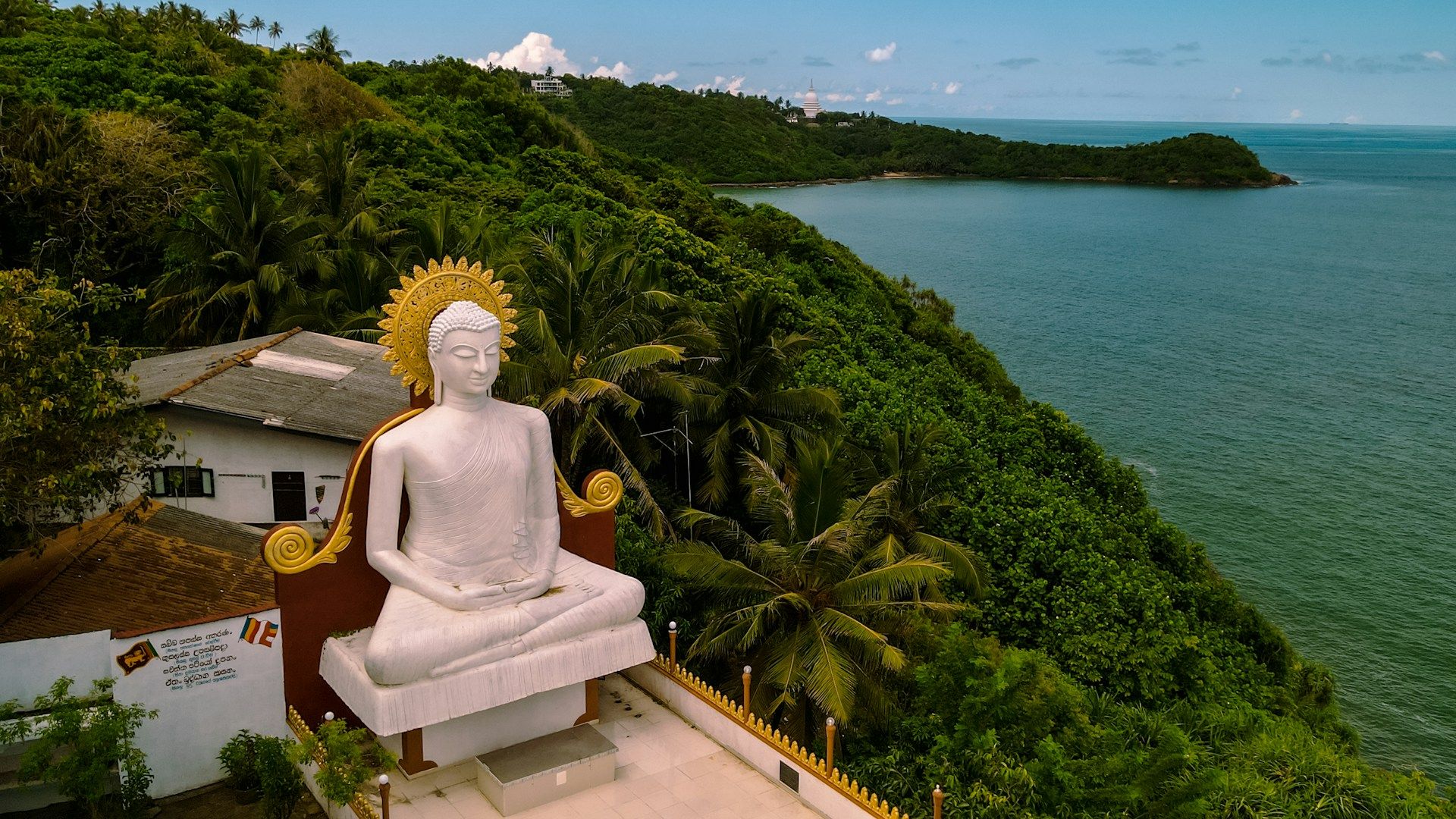Sri Lanka is one of those countries that make for a great destination year-round. Whenever you go, you can explore green tea plantations, relax on golden beaches, see ancient temples in the hills, and walk through lush jungles.
Each season is a bit different, so it’s helpful to know what the weather will be like before you plan your trip. In this guide, you’ll find the best times to visit Sri Lanka, fun things to do, what to pack, and events you might enjoy. Want to know more? Keep reading.

Picture by Yves Alarie on Unsplash
The Best Time to Visit Sri Lanka
Sri Lanka doesn’t have the traditional season that we’re most used to. As we mentioned, the temperature remains warm throughout the year, but the humidity and rainfall patterns do change. We will be discussing the two monsoon seasons, characterized by heavy rainfall and high humidity, as well as the two transitional periods (inter-monsoon
seasons), marked by longer, sunny days.
-
Northeast Monsoon: The “Maha” monsoon. It occurs from December to February, and as the name suggests, it brings rain mainly to the northeastern and eastern parts of Sri Lanka. This means that the southwest, west, and central hill country are drier and sunnier.
-
Southwest Monsoon: The “Yala” monsoon. This one occurs from May to September, and comes from the opposite side, raining all over the southwestern, western, and central parts of Sri Lanka. Meanwhile, the eastern and northern regions stay dry and sunny.
-
Inter-monsoon periods: From March to April and October to November, the entire country experiences similar weather conditions. These are transitional periods, so the weather can be unpredictable, but there’s less rain than during the monsoons.
Should you avoid the monsoons?
Some travelers really don’t like the rain. And I get it. It doesn’t have to be everyone’s favorite, and it has a tendency to ruin plans. But let’s examine how accurate these assumptions really are.
-
It rains all the time: Not really. There’s a lot of humidity and rain; yes, the rain can be pretty heavy. But most commonly, you’ll see short bursts of rain either in the morning or late in the afternoon. So no need to cancel all plans!
-
It causes itinerary disruptions: Some plans might get canceled, especially if you travel with a very tight itinerary. Some roads are closed due to flooding, trains are running late, and outdoor tours have been rescheduled. You can either opt for indoor activities (we have plenty of suggestions) or choose a flexible schedule.
-
Low visibility, bad lighting: If you’re a landscape photographer or a drone enthusiast, you might want to skip the season altogether. The cloudy skies don’t offer the best lighting, and the rain makes the landscape less visible.
Why go to Sri Lanka during the monsoon season?
And yet, some people actively prefer the monsoon season to travel to Sri Lanka. So let’s check what they have to say.
-
Lush landscape: You might not notice it during the rain, but afterwards, you’ll see how incredibly lush and green everything looks. There’s a lot of new life growing everywhere in the tea plantations, forests, and gardens.
-
Fewer tourists: This has two meanings, and attracts two different kinds of travelers. First, there are those who dislike large crowds and prefer to enjoy public spaces without the noise of tourists. And then there are those who want to take advantage of the heavy discounts of the season.

Photo by Siarhei Palishchuk on Unsplash
Best activities for the monsoon season
-
Explore the Cultural Triangle: Even during the rains, this area is oftentimes spared. So take the chance and visit it with fewer tourists! Check the Sigiriya Rock Fortress, and climb it amidst the fresh monsoon rains to see the waterfalls cascading down the side. Don’t miss the ancient capital of Polonnaruwa, or the sacred Buddhist site in Anuradhapura.
-
Join an Ayurvedic wellness program: This one is perfect for spiritual travelers who seek to gain a deeper understanding of the Sri Lankan knowledge about the relationship between the body and the mind. We are what we eat after all, so try their detox programs and dietary regimes to promote deep rejuvenation and mental clarity.
Tips for traveling during the monsoon season
-
Pack smart: Pack clothes that dry quickly, and don’t forget your waterproof gear. Especially the footwear, you’ll need a good grip if you’re exploring in the rain.
-
Embrace flexible, slow travel: You can get mad and frustrated when a delay occurs, or you can accept it and make the best of it. Neither will fix the delay, so it’s better to be proactive and flexible, keeping a plan B and C.
-
Accommodations that match the vibe: This one might be a little harder to check, but a hotel with a cozy reading nook is just the stay you need in Sri Lanka during the monsoon season. Another option is mountain views, as they look magical in the rain.
Best and worst of the inter-monsoon season
Let’s talk now about what traveling during the inter-monsoon season is like, both the good and the bad, so you get the whole picture. The great inter-monsoon season:
-
Island-wide accessibility: If you’re planning to travel through the whole island, the absolute best time is during the first inter-monsoon season, from March to April. The entire region is accessible, allowing you to explore both coasts, the central highlands, and the major cultural zones.
-
Cultural Festivals: For example, there are the Sinhala and Tamil New Year celebrations in mid-April. One of the biggest celebrations in Sri Lanka, with traditional games, sweets, rituals, and family gatherings.
-
Fewer tourists: This is more specifically from October to mid-November, which is considered the shoulder season, so you’ll get a more cultural experience and better prices.
The not-so-great part of the inter-monsoon season:
-
Increased humidity and heat: Unfortunately, for travelers, March and April are also among the hottest and most humid months in Sri Lanka, making sightseeing a draining experience. Only in the coastal regions is there some breeze.
-
Unpredictable weather: Both inter-monsoon seasons have this characteristic. In March and April, you can encounter brief but intense thunderstorms, while in October and November, is a bit more chaotic, with the possibility of sudden rain anywhere on the island.
Best activities to do during the inter-monsoon seasons
-
Join in the Celebration of Sinhala and Tamil New Year: If you’re planning a trip to Sri Lanka, one of the best times to go is in April. There are several reasons, but one of them is the celebration of the New Year. It’s a nationwide party with firecrackers at dawn, milk boiling ceremonies, and plenty of rituals for prosperity. Traveling during this time offers the opportunity to experience authentic Sri Lankan hospitality as families come together to celebrate.
-
Scenic Train Rides of the Hill Country: It’s a famous train ride for a good reason! No matter what the season, it is spectacular, but particularly so during the inter-monsoons, as the scenery is more lush and vibrant due to the abundant rain. It will give you a good view of the whole country, as you pass rolling tea estates, waterfalls in full flow, and cloud-covered valleys.
-
Wildlife safaris: The inter-monsoon seasons are ideal for spending long hours outdoors, and what better activity than a safari? You have national parks like Yala, Udawalawe, and Wilpattu, all offering incredible views and diverse wildlife to discover. There are hundreds of birds, elephants and leopards, sloth bears, and even crocodiles.
Tips for traveling during the inter-monsoon season
-
Plan your outdoor activities for the morning: Rain is more common in the afternoons, and with busy outdoor mornings and more relaxed indoor afternoons, you’ll also have a more balanced trip.
-
Check road conditions in rural areas: Even in the “dry” season, localized flooding or mudslides are still common. If you’re traveling remotely, consider hiring a local driver who is familiar with the terrain.
-
Try the free Yoho Mobile eSIM: If you’re going remote into the island, you’ll need a way to stay connected, and Yoho Mobile is paired with some of the best internet providers in Sri Lanka. Afterward, use the code YOHO12 for 12% off your next purchase.
Final Words
The best time to visit Sri Lanka depends on the kind of travel that you’re looking for. If you don’t fear the rain and are flexible with your plans, the monsoon seasons offer a great option. If you prefer clearer skies and more outdoor adventures, then the inter-monsoon seasons are for you. After all, no matter when you go, Sri Lanka is an unforgettable destination.
